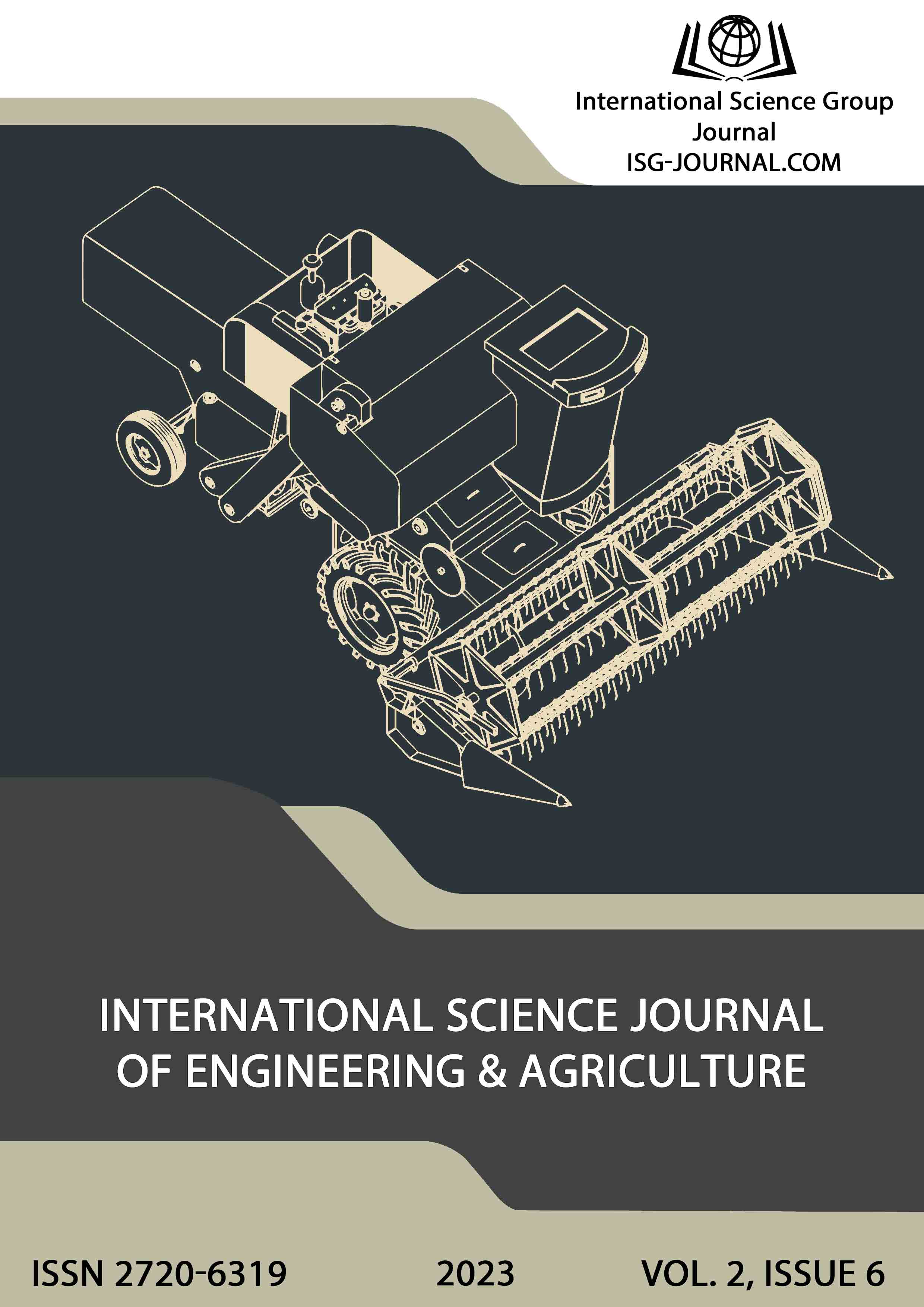The influence of pumpkin protein concentrate on the technological process of wheat bread production
DOI:
https://doi.org/10.46299/j.isjea.20230206.11Keywords:
bread, pumpkin protein concentrate, lecithin, protein, infrared spectroscopy, gas-forming capacityAbstract
The aim of the work was to determine the influence of pumpkin protein concentrate in combination with sunflower lecithin on the course of microbiological processes in dough and changes in structural units in dough and bread made from wheat flour. Pumpkin and its processing products are used in the technology of making bakery products. Due to lipid nature and emulsifying properties of lecithin, it contributes to the improvement of the structural and mechanical properties of the dough. The gas-forming capacity of the dough with lecithin increased by 0.9%, and with pumpkin protein concentrate, when the dosage was increased, it decreased by 2.3–12.5% compared to the sample without this raw material. This indicated deterioration of the fermentative capacity of the yeast. The first peak of gas formation on the graph of the dynamics of carbon dioxide release in the dough with the addition of lecithin was observed after 60 min, after the addition of 5–20% pumpkin protein concentrate it shifted to 65 min, while in the control - after 50 min. As the dosage of pumpkin protein concentrate increased, the amount of carbon dioxide released in the dough decreased. The reason for this is a decrease in the availability of wheat flour starch for amylolysis. The second peak of gas formation for the control sample was observed after 150 min, and for samples with pumpkin protein concentrate – 15 minutes later. Pumpkin protein concentrate has a high protein content, which is significantly differs from flour proteins. This can be seen in the infrared reflectance spectra immediately after mixing at a wavelength of 2100 nm. The relative reflectivity of the control sample of the dough after kneading was 0.34, and that of the sample with protein concentrate was 0.32. This indicated that even such a small percentage caused conformational changes. Adding pumpkin protein concentrate in combination with lecithin to the recipe of wheat bread had a positive effect on the biological value of the bread and gives it health-promoting properties.References
Mala, K. S., Kurian A. E. (2016). Nutritional composition and antioxidant activity of pumpkin wastes. International Journal of Pharmaceutical, Chemical & Biological Sciences, 6(3), 336-344.
Różyło, R., Gawlik-Dziki, U., Dziki, D., Jakubczyk, A., Karaś, M., & Różyło, K. (2014). Wheat Bread with Pumpkin (Cucurbita maxima L.) Pulp as a Functional Food Product. Food technology and biotechnology, 52(4), 430–438. https://doi.org/10.17113/ftb.52.04.14.3587
Tomić J. M., Torbica A. M., Belović M. M., Popović L. M., Čakarević J. C., Savanović D. M., Novaković A. R., Mocko Blažek K. A. (2018). Potential of pumpkin oil cake protein isolate in production of millet bread. Food and Feed Research, 45 (2), 139-147. DOI: 10.5937/FFR1802139T
China, M. A., Deedam, N. J., Olumati, P. N. (2020). Effect of fluted pumpkin seeds flour on the proximate and sensory properties of cooking banana flour biscuits and queens cake for household consumption. Research Journal of Food Science and Nutrition, 5(2), 30-34. https://doi.org/10.31248/RJFSN2019.082
Verheyen, C., Albrecht, A., Elgeti, D., Jekle, M., Becker, T. (2015). Impact of gas formation kinetics on dough development and bread quality. Food Research International, 76(3), 860–866. https://doi.org/10.1016/j.foodres.2015.08.013
Munteanu, G.-M., Voicu, G., Ferdeș, M., Ștefan, E.-M., Constantin, G.-A., Tudor, P. (2019). Dynamics of fermentation process of bread dough prepared with different types of yeast. Scientific Study & Research, 20(4), 575–584.
Litvynchuk, S., Galenko, O., Cavicchi, A., Ceccanti, C., Mignani, C., Guidi, L., Shevchenko, A. (2022). Conformational Changes in the Structure of Dough and Bread Enriched with Pumpkin Seed Flour. Plants, 11, 2762. https://doi.org/10.3390/plants11202762
Niewitetzki, O., Tillmann, P., Becker, H.C., Mollers, С. (2010). A new near-infrared reflectance spectroscopy method for high-throughput analysis of oleic acid and linolenic acid content of single seeds in oilseed rape (Brassica napus L.). Journal of Agricultural and Food Chemistry, 58, 94–100. https://doi.org/10.1021/jf9028199.
Yip, W.L., Gausemel, I., Sande, S.A., Dyrstad, K. (2012). Strategies for multivariate modeling of moisture content in freeze-dried mannitol-containing products by near-infrared spectroscopy. Journal of Pharmaceutical and Biomedical Analysis, 70, 202–211. https://doi.org/10.1016/j.jpba.2012.06.043.
Shevchenko, A. (2018). Biochemical processes in the dough for diabetic bakery products, enriched with proteins and food fibers. Scientific Works of National University of Food Technologies, 24(2), 187-194. https://doi.org/10.24263/2225-2924-2018-24-2-22
Zaparenko, A, Didenko, S, Holyk, O, Goloventsov, Y. (2020). Investigation of the technological properties of emmer flour. Food science and technology, 14(2), 111-119. https://doi.org/10.15673/fst.v14i2.1717
Zhygunov, D., Marchenkov, D., Lebedenko, T. (2019). Adjusting flour quality by enzymes: current state, problem analysis, future development prospects. Food science and technology, 13(2), 24-33. http://dx.doi.org/10.15673/fst.v13i2.1380
Sozer, N., Nordlund, E., Ercili-Cura, D., Poutanen, K. (2017). Cereal Side-Streams as Alternative Protein Sources. Cereal Foods World, 62(4), 132-137. https://doi.org/10.1094/CFW-62-4-0132
Baslar, M., Ertugay, M.F. (2011). Determination of protein and gluten quality-related parameters of wheat flour using near-infrared reflectance spectroscopy (NIRS). Turkish Journal of Agriculture and Forestry, 35(2), 139–144. https://doi.org/10.3906/tar-0912-507
Alfaris, N. A., Gupta, A. K., Khan, D., Khan, M., Wabaidur, S. M., Altamimi, J. Z., Alothman, Z. A., Aldayel, T. S. (2022). Impacts of wheat bran on the structure of the gluten network as studied through the production of dough and factors affecting gluten network. Food Science and Technology (Campinas), 42(3), https://doi.org/10.1590/fst.37021
Vélez, A.P.E., Pagán, J., Ibarz, A. (2012). Melanoidins Formed by Maillard Reaction in Food and Their Biological Activity. Food Engineering Reviews, 4(4), 203-223. https://doi.org/10.1007/s12393-012-9057-9
Downloads
Published
How to Cite
Issue
Section
License
Copyright (c) 2023 Anastasiia Shevchenko

This work is licensed under a Creative Commons Attribution 4.0 International License.






